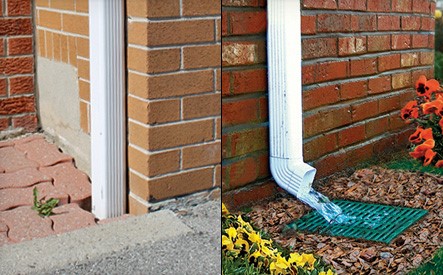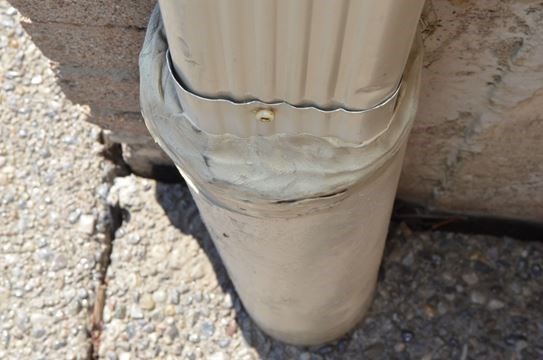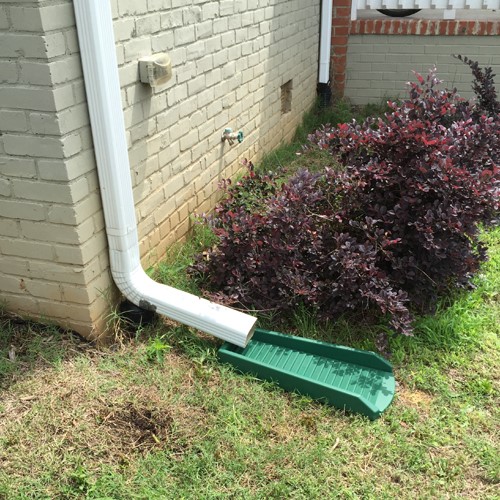How to Disconnect a Downspout
During a rainstorm, gutters and downspouts can collect and distribute hundreds of litres of water from a roof. This can cause some basements to leak or flood if there are undetected cracks in walls.
To help prevent this, homeowners can disconnect downspouts to direct water above ground and away from the walls of a house. Doing this will allow water to be absorbed into the lawns and replenish the ground water. Below is a simple way to fix your water problems caused by improper drainage.
How to disconnect a downspout
Materials needed:
- hacksaw
- tape measure
- hammer
- screw driver
- pliers
- sheet metal screws
- downspout elbow
- downspout extension
- splash block (optional)
- rubber cap
Step one: Measure at least 23 cm (nine inches) from where the downspout enters the sewer connection.
Step two: Cut the downspout with a hacksaw.
Step three: Cap the sewer standpipe. This prevents water from going in. You can use a simple rubber cap secured by a hose clamp. A wing-nut test plug can be used if available cap sizes do not fit.
Step four: Insert the downspout into the elbow (if the elbow is inserted into the downspout, it will leak). The end of the downspout may need to be crimped with a pair of pliers to get a good fit. Attach a downspout pipe extension to carry water away from the house and foundation. A hacksaw can be used to cut the extension to the desired length. Be sure to insert the elbow into the extension to prevent leaks. Secure the elbow and extension with sheet metal screws. A splash pad can be placed at the end of the extension where the water drains to prevent erosion.
Note: When redirecting the rain water from the disconnected downspout, water should flow onto your grass or garden.
It is important to ensure that:
- Water flows away from your foundation walls
- Water does not negatively impact your neighbours’ property
- Water does not flow directly onto a sidewalk
 |  |
Helpful hints
- To help prevent damage to your house, clean eavestroughs. They can become blocked with leaves and dirt, causing them to overflow and possibly damaging the home’s roof, soffits and foundation.
- Keep catchbasins in front of the home free of debris. If catchbasin grates are blocked, water is unable to enter into the storm water system.
- Reduce and conserve water. Rain barrels capture and store the water that lands on a home’s roof. This stored water is excellent for watering your lawn and garden.
- Examine the grade of a property. The ground around a house should slope away from the house for at least three metres.
- Naturalize. Use trees, shrubs and gardens to restore natural water cycles on the property. Replace hard surfaces with permeable surfaces to allow rainfall to soak into the ground. Trees are nature’s most efficient water managers.
- Inspections. Check all doors, windows, foundations and floors for cracks and leaks. Make any necessary repairs, where possible.
Ground water re-charge system clean water collection
Residents that live on the streets listed below may be connected to a clean water collection system. If this is the case, downspout disconnection is not required.
Aaron Goodbaum Court Allison Ann Way Alex Black Street Daniel Bram Drive Dimarino Drive Donzi Lane Eagle Landing Road Ferritti Street Giordano Way Gladue Street Israel Zilber Drive Lady Angela Lane Lady Dolores Avenue Lady Fenyrose Avenue Lady Jessica Drive Lady Karen Crescent Lady Loretta Lane Lady Nadia Drive Lady Valentina Avenue Lady Veronica Lane Little Celeste Court Little Hannah Lane | Little Marco Count Little Natalie Court Luca Avenue Nancy Count Prolo Court Queen Filomena Avenue Rivermill Crescent Robert Green Crescent Sir Francesco Street Sir Giancarlo Court Sir Stevens Drive Sofia Olivia Crescent Sweet Anna Court Sweet Valeri Court Torah Gate Vanda Drive Via Romano Boulevard William Bowes Boulevard Woodville Lane Yemina Gate Zoran Lane |
Disclaimer: The City cannot guarantee the accuracy or completeness of the information or its application to any particular property. Homeowners, where possible, should verify the information before acting on it. Where appropriate, professional advice and service should be sought from a knowledgeable and licensed contractor or civil engineer. While the City endeavours to provide accurate information, it is provided strictly "as is" and the City makes no representations or warranties as to the accuracy, reliability, completeness, currency, or suitability of the information provided. Readers relying on this information and this website do so entirely at their own risk. In no event will the City be liable to you or anyone else for any decision made or action taken by you or anyone else in reliance on this information. The City does not accept and specifically disclaims any and all liability for any injury, loss or damage whatsoever incurred as a result of the use of, reliance on, the information provided by the City and in no event will the City, its Councillors, officers, directors, employees or contractors be liable to you or to any third party for any direct, indirect, incidental, consequential, special or exemplary damages or lost profit, including any property damage or loss or personal injury, associated with, resulting from or arising out of any use or misuse of this information.
Additional Resources
- I Don't Flush Campaign
- Sewer Use By-law 087-2016 (PDF)
- Sewer Use By-law FAQs (PDF)
- Water and Wastewater Financial Services Department
- York Region and Municipal Inflow and Infiltration Reduction Program
- York Region Disposal of Fats, Oils and Grease Disposal brochure (PDF)
- York Region Hazardous Waste Depot
- York Region Industrial Disposal of Fats, Oils and Grease brochure (PDF)
